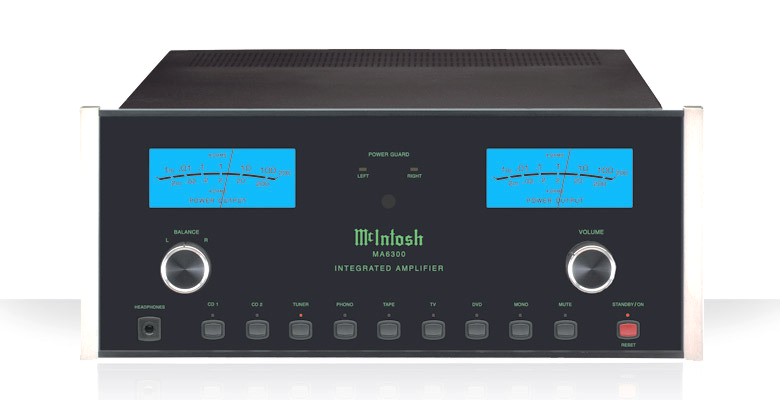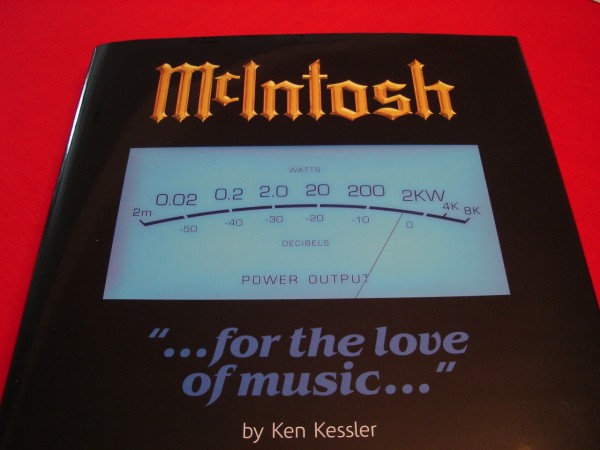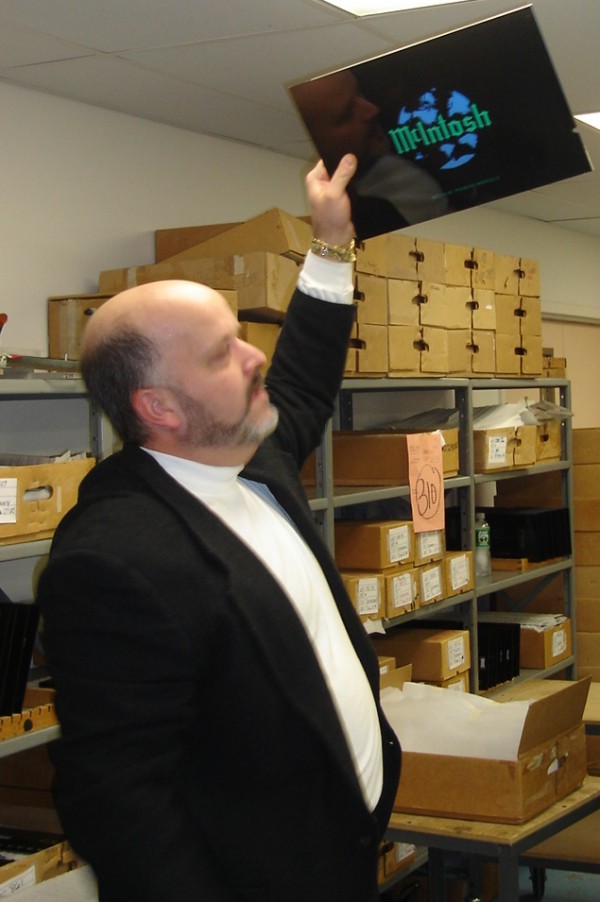
Introduction to the McIntosh MA6300
A friend I hadn’t seen in quite some time invited me to his home, and we talked about many things, including our common audio interests. I mentioned casually that I was in the middle of auditioning the new MA6300 integrated amplifier from McIntosh. But this was a social trip, and I was most anxious to see his newly acquired dream wheels, the kind with 12 cylinders behind you and a front-end inches above the pavement – his new exotic Lambo.
If you’ve ever had the pleasure of sitting in a Lamborghini Diablo, you’ll know that the doors don’t swing out but swivel or pivot up. That’s cool enough, but as the door swiveled open, the speaker mounted on the door panel was none other than a McIntosh. I said, “Hey you have McIntosh speakers in this car!” To which he replied, “I do, really?”
I suppose that if you bought an Italian car that drives 200 mph and has an engine that roars like a lion, you might not have paid attention to the audio system.
Specifications
- Design: Integrated Stereo
- Power: 2 x 100 Watts RMS into 8 Ohms, 160 Watts into 4 Ohms
- MFR: 20 Hz – 20 kHz
- THD+N: 0.005%
- Inputs: XLR and RCA
- MM Phono Input
- Pre-Outs and Pre-Ins
- Dimensions: 7.6″ H x 17.5″ W x 22″ D
- Weight 37 Pounds
- MSRP $3,000 USA
- McIntosh
But I Digress
Frank McIntosh or Mr. “Mac” as he was affectionately known, began his company in the late 1940s as McIntosh Engineering Laboratory. It had its roots in Maryland, and then moved to its current home in Binghamaton, New York, in the early 1950s.
 Anyone with any interest in this hobby who hasn’t read Ken Kessler’s excellent book on the legendary company should find a copy. It’s not only very informative and intuitively laid out, but it’s a great looking book too.
Anyone with any interest in this hobby who hasn’t read Ken Kessler’s excellent book on the legendary company should find a copy. It’s not only very informative and intuitively laid out, but it’s a great looking book too.
Most of us know that McIntosh is part of the larger D&M Holdings group which includes the likes of Denon, Marantz, Boston Acoustics, Snell and some others. In 1990, the year Frank McIntosh passed away, Clarion of Japan purchased McIntosh, then sold it to D&M Holdings in 2003. The smartest thing D&M had done after acquiring McIntosh was to leave them alone in Binghamton to do what they do best. With the infusion of additional funds, McIntosh has indeed gone on to excel.
My Tour at the McIntosh Labs Factory
You may recall my report on the tour I took of the factory back in 2006 . 2 Chambers Street, the locale familiar to McIntosh followers, was our gathering place. We sat in a new training room, where several times a year, McIntosh brings retailers to begin their two-day training course known as McMasters Graduate Program.
 Our guide for the tour was the current President Charlie Randall, who’s been at his tenure since April of 2001, and who originally joined the company in 1988. With 18 years under his belt, Charlie’s length of time at McIntosh was the norm for employees.
Our guide for the tour was the current President Charlie Randall, who’s been at his tenure since April of 2001, and who originally joined the company in 1988. With 18 years under his belt, Charlie’s length of time at McIntosh was the norm for employees.
This became quite the story – most on the assembly floor were dedicated people who’d been there for many years – some as many as 40 years. Most had been there from 15 to 25 years and I sensed immediately the pride in their craft. Charlie knew them all by their first names.
As sophisticated as the assembly process is, most is still done by hand. Including the circuit boards that are “stuffed” by very noisy machines, what you get in your McIntosh is good old American pride and craftsmanship from some very sure hands.
During our break I was fortunate to have lunch with Bob Weissburg, the Sales and Marketing President at D&M Holdings and he summed up the tour best. When you see the final McIntosh unit assembled you can’t help but simply want one. I knew what he meant – I wanted one . . . or two.
The MA6300 integrated amplifier was my opportunity. I was intrigued because this McIntosh was affordable to me. What makes it affordable is all solid state construction which uses machine-stuffed circuit boards, and modest power output.
The MA6300 Design
The MA6300 puts out 100 watts into 8 ohm and 160 watts into 4 ohm loads, all at 0.005% THD between 20 Hz and 20 kHz ± 0.5 dB. Like most McIntosh components, the MA6300 is quite tall at almost 8″ leaving plenty of air in the cabinet. Weighing 37 pounds it comes beautifully packaged and mounted to a stiff wood skid in which you must remove the plastic feet – the shipping weight is then 55 pounds! I do recommend hanging onto the packing material, as Mac owners like to send their units back after a decade or so, to have the unit re-calibrated. The manual also tells you how to re-pack the unit!

The front panel is distinguished classic McIntosh – back painted black glass and the familiar analog needle VU meters for power output. Below each left/right meter is a large knob, one for balance and the other for volume, quite straightforward. Seven input selections along the bottom with soft toggle switches include CD1 (with balanced XLR inputs) and CD2 with RCA inputs.
Also find inputs for a Tuner, Phono, Tape, TV, and DVD. A Mono and Mute button are also conveniently placed. Symmetrical to the infinite detail, each end is matched with a red on/off switch and the other side a headphone jack with outputs rated for 16 to 250 ohm impedance.
LED power guard indicators for both left and right channels will illuminate if the audio signal peaks, or if the MA6300 overheats (it will temporarily shut down and return to normal operating temperature). McIntosh refers to this as “ThermalTrak™”. The transistors will monitor bias, make adjustments if necessary, and run cool.

With plenty of real estate on the rear, there are RCA stereo inputs for each input listed above, including the balanced connections for a CD player. The MM Phono input has the convenient ground. Left and right speaker posts are nicely separated from the inputs.
By providing preamp outputs (pre-out) and power amp inputs (pre-in), McIntosh designs into the MA6300 the use of either a separate preamplifier or amplifier by removing the jumper plugs.
Additional power controls allow the MA6300 to use 1/8″ jacks for activating other components, and likewise a “Sum Data Port” sends data signals to another McIntosh source component, thereby allowing the Remote Control supplied with the MA6300 to control it. Additional data ports allow the remote control to operate other McIntosh components.
The MA6300 Remote Control

The remote control is above average and quite elegant – what else would we expect from McIntosh? Consistent with the component, the unit is black with gold lettering, if that matters to you, and it does to Mac owners. The unit is intuitively arranged and nicely backlit.
Setup of the MA6300
The owner’s manual is not only handsome, but thorough, with information and precise graphics. I always appreciate the manufacturer making the effort.
Mating the MA6300 with speakers was an easy task for me, as I also had on hand a pair of KEF Reference full-range floorstanding speakers for review. My own reference Krix Symphonix was the standard for comparison; I also couldn’t help comparing the McIntosh with an integrated tube amp, my Onix H6550.
For CD players, I used a McCormack UDP-1 universal player which doesn’t have balanced outputs, so that part of the MA6300 went untried until my Benchmark DAC came along and I was able to audition music from my computer. Later on I added the Oppo DV-983H. The turntable used was from Marantz, while the speaker cables and interconnects were from Goertz and power cords from Wireworld.
One thing that doesn’t change is my listening space – 12 ft wide, 16 ft deep and 8 ft ceilings with modest acoustic treatment.
The MA6300 Sound
The overall presentation of the MA6300 is a clean dynamic response across the frequency spectrum – no bloated flat lows, nor shrilly highs. Midrange however is probably where this amplifier excels, just slightly. I’d expected that, as a solid state component, the bottom end would be most impressive Yet as much as I found bass adequately deep, I was captivated by the warmer silvery guitar and earthy piano tones.
Stanley Jordon’s Live in New York CD, particularly track 5, “Flying House” is as warm as you’ll ever hear an electric guitar sound, yet the clarity of his string plucking (or in this case tapping), is articulate.
Musica Pacifica’s Vivaldi: La Notte Concerti per strumenti diversi is an excellent CD for articulating and separating instruments. Soundstage is defined, wide, and deep. To reiterate, bass was more than healthy – bassoon and cello were so well delivered that the accompanied recorder danced around and through them.
Likewise, listening to the Tallis Scholars with the remarkable ambience of the music halls, typically large chapels, the placement of voices high and low float and the soundstage extends well beyond the speakers. The MA6300 evokes the essence of those live tactile performances.
Midrange vocals from melancholy Lyle Lovett in his amazing soulful CD, Joshua Judges Ruth pushed forward projecting his voice, which was rendered realistically throaty and quite accurate.
On the female side, Rene Marie’s Live at Jazz Standard captivated me with her voice with wonderful clarity and strength, rendering it powerful yet soft.
Much vinyl was played through the MA6300 phono stage, as I’ve enjoyed a resurgence of interest in the medium, but one LP that stuck out was The Avant-Garde with John Coltrane’s sax and Don Cherry’s trumpet – again, excellent separation between instruments, clarity and wonderful timbre with a brassy edge.
Conclusions About the McIntosh MA6300
As a first venture into the McIntosh family of components, the MA6300 is a natural for me. It’s rare that you can say anything you purchase is an investment, yet here it is, the MA6300. I’m pretty sure the MA6300 was designed to bring a new audiophile client into the fold; reliable solid-state construction, a versatile array of inputs, options to upgrade amplifiers (hopefully McIntosh), quality remote, reasonable price, and of course the McIntosh name and all that implies.
For nitpicks, there is a slight edginess to the highs, typical of solid state, and there are times the MA6300 can also sound slightly dry, by that I mean it is always reserved. It basically remains neutral, not adding its own signature to the sound, and it does this very well. I would have liked tone controls, but of course, tone controls go away when you reach this level of performance.
It’s very easy to like McIntosh products – the sexy UV meters glowing green, more than adequate power to drive the most demanding speakers, very low distortion, and a neutral presentation. The MA6300 will surely extend the Mr. Mac’s family into homes of music lovers and audiophiles alike, regardless of budget. The MA6300 gives you options and an opportunity to afford a piece uniquely American that you’ll be happy with for a long, long time.


